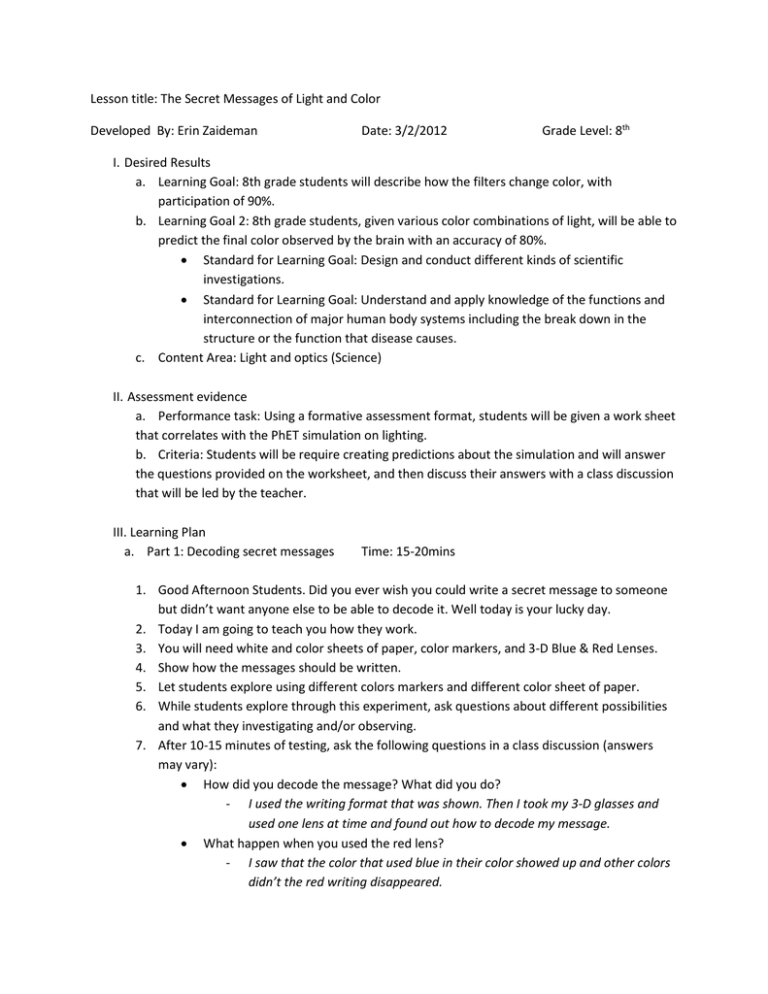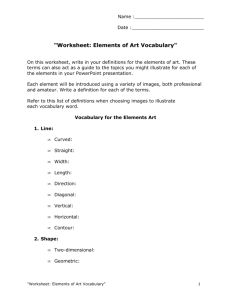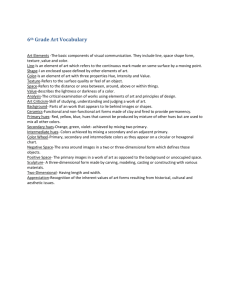File - Ms. Erin Zaideman
advertisement

Lesson title: The Secret Messages of Light and Color Developed By: Erin Zaideman Date: 3/2/2012 Grade Level: 8th I. Desired Results a. Learning Goal: 8th grade students will describe how the filters change color, with participation of 90%. b. Learning Goal 2: 8th grade students, given various color combinations of light, will be able to predict the final color observed by the brain with an accuracy of 80%. Standard for Learning Goal: Design and conduct different kinds of scientific investigations. Standard for Learning Goal: Understand and apply knowledge of the functions and interconnection of major human body systems including the break down in the structure or the function that disease causes. c. Content Area: Light and optics (Science) II. Assessment evidence a. Performance task: Using a formative assessment format, students will be given a work sheet that correlates with the PhET simulation on lighting. b. Criteria: Students will be require creating predictions about the simulation and will answer the questions provided on the worksheet, and then discuss their answers with a class discussion that will be led by the teacher. III. Learning Plan a. Part 1: Decoding secret messages Time: 15-20mins 1. Good Afternoon Students. Did you ever wish you could write a secret message to someone but didn’t want anyone else to be able to decode it. Well today is your lucky day. 2. Today I am going to teach you how they work. 3. You will need white and color sheets of paper, color markers, and 3-D Blue & Red Lenses. 4. Show how the messages should be written. 5. Let students explore using different colors markers and different color sheet of paper. 6. While students explore through this experiment, ask questions about different possibilities and what they investigating and/or observing. 7. After 10-15 minutes of testing, ask the following questions in a class discussion (answers may vary): How did you decode the message? What did you do? - I used the writing format that was shown. Then I took my 3-D glasses and used one lens at time and found out how to decode my message. What happen when you used the red lens? - I saw that the color that used blue in their color showed up and other colors didn’t the red writing disappeared. What happen when you used the blue lens? - I saw that either all the words showed or the red messages pop out. What colors were easier to use? What colors made the message more difficult to decode? - Blue and red were easy to use for decoding. Varying answers. What happen when you used different color paper? - Dark paper: see the red pigments of words better - Light paper: see the blue pigments of words better Did the colors of the words change under each lens? If so, What did they change to and why? - Red lens- blue, green, and purple looked black. Why, answer varies. - Blue lens- red words looked purple. Why answer varies. 8. Clean up supplies and pass out work sheets for part 2 of lesson. b. Part 2: PhET Simulation Time: 10-15 minutes 1. After the students receive worksheet 2. Ask students to list all the combination that various paint colors mix with other paint colors make, such as Red & Blue = Purple, so on. 3. Ask students what they predict will happen when we mix combination of the colors together through light, using blue, green, and red light. 4. Ask students to give their own combination of colors (blue, green, and red) and try them on the simulation, and have them write down their results on their worksheet. 5. Repeat step 4, 4-5 times. 6. Ask students to follow the questions on the worksheet, have them predict what color will come out, and then test. 7. Answers to the following questions from the worksheet are: What color do you see when you mix red light with green light? - Yellow What happens when you make the red light dimmer? - The guys sees more of a green color or lime What happens when you make the green light dimmer? - The guys sees more of a orange color What color do you see when you mix red light with blue light? - Fuchsia What happens when you make the red light dimmer? - Indigo or bluer color What happens when you make the blue light dimmer? - Darker pink or redder color What color do you see when you mix green light with blue light? - Aqua What happens when you make the green light dimmer? - Sky blue What happens when you make the blue light dimmer? - Teal 8. Ask students what happens when you mixed all the paint colors together? (Black) 9. Ask students what happens when you mixed all blue, red and green light together? (White) 10. Ask students to answer the last question on the sheet, What are the difference between mixing lights colors than mixing paint colors, and how do you think light colors are able to combine together and create certain colors? 11. Give students the remainder of the period to fill out the worksheet, explore the simulation or the part 1 of the lesson. IV. Steps for students Create predictions Participate throughout lesson Volunteer answers See the difference between mixing paint and light colors together Share 3-D’s lens appropriately Completely fill out the worksheet given Be respectful to teacher and students V. Materials Markers White paper Color paper 3-D blue and red lens Worksheet PhET simulation: Color Vision LCD project Computer VI. Approximate time Total: 40 minutes. Transition from part 1 to part 2 of lesson 10 minutes. VII. Modifications No modifications needed for this lesson. VIII. Resources http://phet.colorado.edu/en/simulation/color-vision Robertson, William C. "Colorful Waves." Stop Faking It!: Finally Understanding Science s You Can Teach It. Arlington, VA: National Science Teachers Association, 2002. Name__________________ Date___________ Mixing Light to become Bright! What do you think happens when you use blue, green, and red light? Answer the following questions, and then as a class, we will see if your prediction came true. 1. What color do you see when you mix red light with green light? 2. What happens when you make the red light dimmer? 3. What happens when you make the green light dimmer? 4. What color do you see when you mix red light with blue light? 5. What happens when you make the red light dimmer? 6. What happens when you make the blue light dimmer? 7. What color do you see when you mix green light with blue light? 8. What happens when you make the green light dimmer? 9. What happens when you make the blue light dimmer? 10a. What are the differences between mixing lights colors than mixing paint colors? 10b. How are light colors able to combine together and create the colors we made today?




